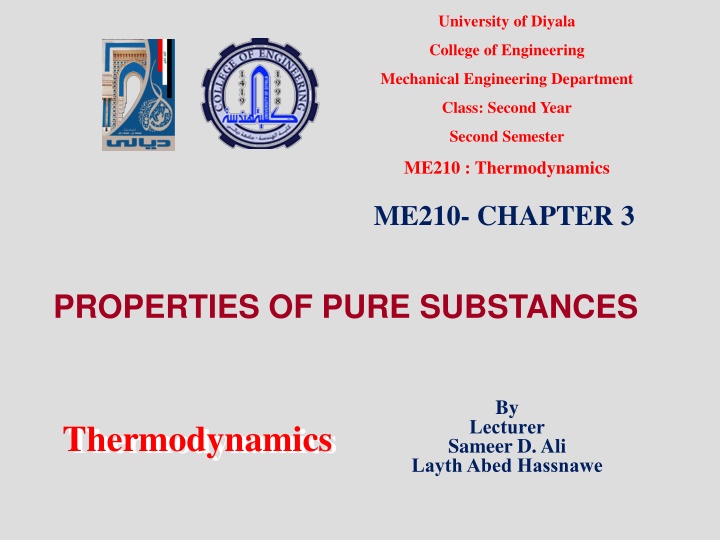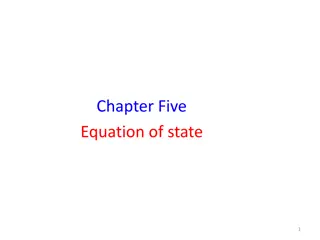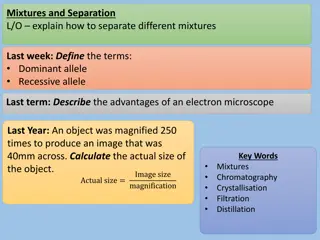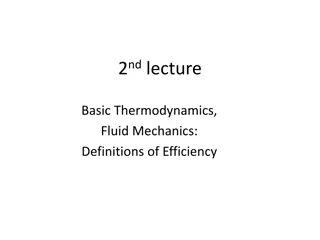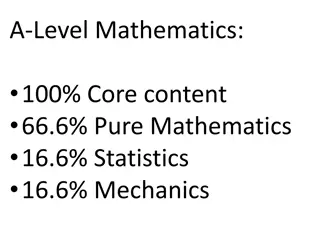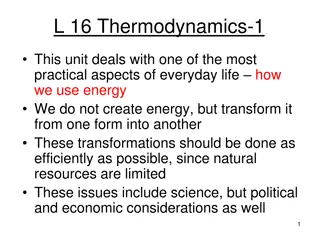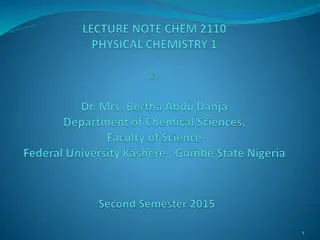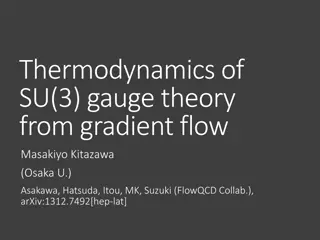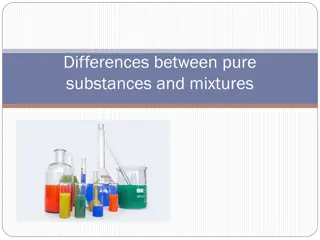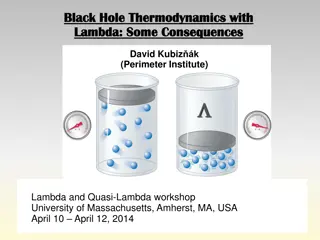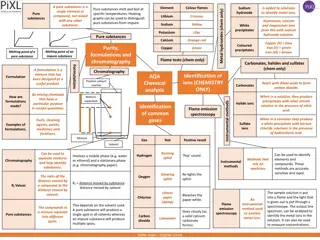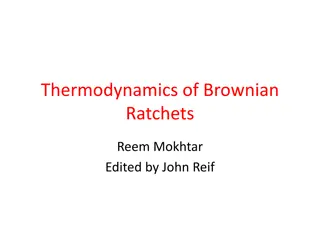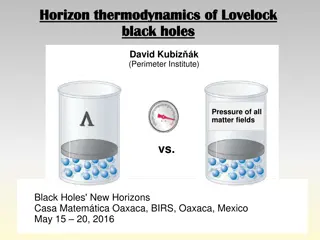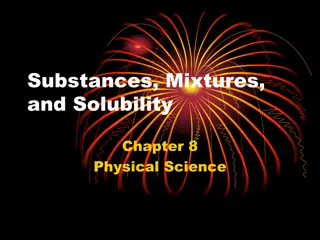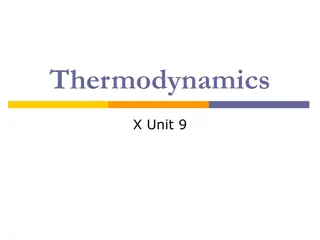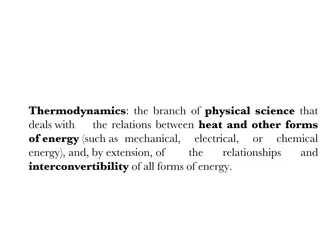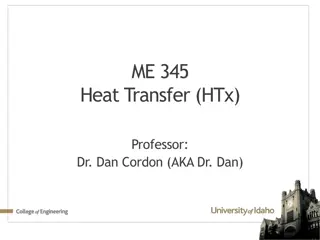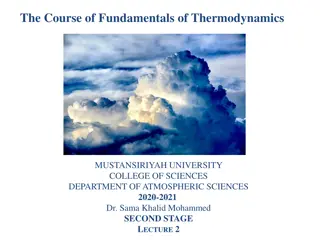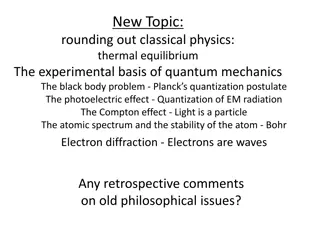Properties of Pure Substances in Thermodynamics
In thermodynamics, understanding the properties of pure substances is crucial. Pure substances have fixed chemical compositions, with phases like solid, liquid, and vapor. The phase-change processes involve compressed liquid, saturated liquid, saturated vapor, and superheated vapor. Saturation temperature and pressure play key roles in determining the state of a substance. By examining T-v diagrams, the behavior of substances during heating and cooling processes can be understood.
Download Presentation

Please find below an Image/Link to download the presentation.
The content on the website is provided AS IS for your information and personal use only. It may not be sold, licensed, or shared on other websites without obtaining consent from the author.If you encounter any issues during the download, it is possible that the publisher has removed the file from their server.
You are allowed to download the files provided on this website for personal or commercial use, subject to the condition that they are used lawfully. All files are the property of their respective owners.
The content on the website is provided AS IS for your information and personal use only. It may not be sold, licensed, or shared on other websites without obtaining consent from the author.
E N D
Presentation Transcript
University of Diyala College of Engineering Mechanical Engineering Department Class: Second Year Second Semester ME210 : Thermodynamics ME210- CHAPTER 3 PROPERTIES OF PURE SUBSTANCES By Lecturer Sameer D. Ali Layth Abed Hassnawe Thermodynamics
PURE SUBSTANCE Pure substance:A substance that has a fixed chemical composition throughout. Air is a mixture of several gases, but it is considered to be a pure substance. 2
PHASES OF A PURE SUBSTANCE The molecules in a solid are kept at their positions by the large springlike inter-molecular forces. In a solid, the attractive and repulsive forces between the molecules tend to maintain them at relatively constant distances from each other. 3
PHASE-CHANGE PROCESSES OF PURE SUBSTANCES Compressed liquid (subcooled liquid):A substance that it is not about to vaporize. Saturated liquid: A liquid that is about to vaporize. At 1 atm and 20 C, water exists in the liquid phase (compressed liquid). At 1 atm pressure and 100 C, water exists as a liquid that is ready to vaporize (saturated liquid). 4 Thermodynamics-CH3
Saturated vapor: A vapor that is about to condense. Saturated liquid vapor mixture: The state at which the liquid and vapor phases coexist in equilibrium. Superheated vapor: A vapor that is not about to condense (i.e., not a saturated vapor) As more heat is transferred, the temperature of the vapor starts to rise (superheated vapor). 5 At 1 atm pressure, the temperature remains constant at 100 C until the last drop of liquid is vaporized (saturated vapor). As more heat is transferred, part of the saturated liquid vaporizes (saturated liquid vapor mixture).
If the entire process between state 1 and 5 described in the figure is reversed by cooling the water while maintaining the pressure at the same value, the water will go back to state 1, retracing the same path, and in so doing, the amount of heat released will exactly match the amount of heat added during the heating process. T-v diagram for the heating process of water at constant pressure. 6 Thermodynamics-CH3
Saturation Temperature and Saturation Pressure The temperature at which water starts boiling depends on the pressure; therefore, if the pressure is fixed, so is the boiling temperature. Water boils at 100 C at 1 atm pressure. Saturation temperature Tsat: The temperature at which a pure substance changes phase at a given pressure. Saturation pressure Psat: The pressure at which a pure substance changes phase at a given temperature. The liquid vapor saturation curve of a pure substance (numerical values are for water). 7
Latent heat: The amount of energy absorbed or released during a phase- change process. Latent heat of fusion: The amount of energy absorbed during melting. It is equivalent to the amount of energy released during freezing. Latent heat of vaporization: The amount of energy absorbed during vaporization and it is equivalent to the energy released during condensation. The magnitudes of the latent heats depend on the temperature or pressure at which the phase change occurs. At 1 atm pressure, the latent heat of fusion of water is 333.7 kJ/kg and the latent heat of vaporization is 2256.5 kJ/kg. The atmospheric pressure, and thus the boiling temperature of water, decreases with elevation. 8 Thermodynamics-CH3
Some Consequences of Tsatand PsatDependence The variation of the temperature of fruits and vegetables with pressure during vacuum cooling from 25 C to 0 C. In 1775, ice was made by evacuating the air space in a water tank. 9
PROPERTY DIAGRAMS FOR PHASE-CHANGE PROCESSES The variations of properties during phase-change processes are best studied and understood with the help of property diagrams such as the T-v, P-v, and P-T diagrams for pure substances. T-v diagram of constant-pressure phase-change processes of a pure substance at various pressures (numerical values are for water). 10
saturated liquid line saturated vapor line compressed liquid region superheated vapor region saturated liquid vapor mixture region (wet region) At supercritical pressures (P> Pcr), there is no distinct phase-change (boiling) process. Critical point: The point at which the saturated liquid and saturated vapor states are identical. 11
Extending the Diagrams to Include the Solid Phase For water, Ttp= 0.01 C Ptp= 0.6117 kPa At triple-point pressure and temperature, a substance exists in three phases in equilibrium. 13
Phase Diagram Sublimation: Passing from the solid phase directly into the vapor phase. At low pressures (below the triple-point value), solids evaporate without melting first (sublimation). P-T diagram of pure substances. 13 Thermodynamics-CH3
The P-v-T surfaces present a great deal of information at once, but in a thermodynamic analysis it is more convenient to work with two-dimensional diagrams, such as the P-v and T-v diagrams. 14 Thermodynamics-CH3
PROPERTY TABLES For most substances, the relationships among thermodynamic properties are too complex to be expressed by simple equations. Therefore, properties are frequently presented in the form of tables. Some thermodynamic properties can be measured easily, but others cannot and are calculated by using the relations between them and measurable properties. The results of these measurements and calculations are presented in tables in a convenient format. Enthalpy A Combination Property The combination u + Pv is frequently encountered in the analysis of control volumes. The product pressure volume has energy units. 16
Saturated Liquid and Saturated Vapor States Table A 4: Saturation properties of water under temperature. Table A 5: Saturation properties of water under pressure. Apartial list of T ableA 4. Enthalpy of vaporization, hfg (Latent heat of vaporization): The amount of energy needed to vaporize a unit mass of saturated liquid at a given temperature or pressure. 16 Thermodynamics-CH3
Examples: Saturated liquid and saturated vapor states of water on T-v and P-v diagrams. 17 Thermodynamics-CH3
Saturated LiquidVapor Mixture Quality, x : The ratio of the mass of vapor to the total mass of the mixture. 0: sat. liquid, 1: sat. vapor. The properties of the saturated liquid are the same whether it exists alone or in Quality is between 0 and 1 a mixture with saturated vapor. T emperature and pressure are dependent properties for a mixture. The relative amounts of liquid and vapor phases in a saturated mixture are specified by the quality x. Atwo-phase system can be treated as a homogeneous mixture for convenience. 19
Examples: Saturated liquid-vapor mixture states on T-v and P-v diagrams. 21 Thermodynamics-CH3
Superheated Vapor In the region to the right of the saturated vapor line and at temperatures above the critical point temperature, a substance exists as superheated vapor. In this region, temperature and pressure are independent properties. Compared to saturated vapor, superheated vapor is characterized by At a specified P, superheated vapor exists at a higher h than the saturated vapor. Apartial listing of T ableA 6. 22
Compressed Liquid Compressed liquid is characterized by The compressed liquid properties depend on temperature much more strongly than they do on pressure. y v, u, or h Amore accurate relation for h Acompressed liquid may be approximated as a saturated liquid at the given temperature. 21
Reference State and Reference Values The values of u, h, and s cannot be measured directly, and they are calculated from measurable properties using the relations between properties. However, those relations give the changes in properties, not the values of properties at specified states. Therefore, we need to choose a convenient reference state and assign a value of zero for a convenient property or properties at that state. The reference state for water is 0.01 C and for R-134a is -40 C in tables. Some properties may have negative values as a result of the reference state chosen. Sometimes different tables list different values for some properties at the same state as a result of using a different reference state. However, In thermodynamics we are concerned with the changes in properties, and the reference state chosen is of no consequence in calculations. 22
THE IDEAL-GAS EQUATION OF STATE Equation of state: Any equation that relates the pressure, temperature, and specific volume of a substance. The simplest and best-known equation of state for substances in the gas phase is the ideal-gas equation of state. This equation predicts the P-v-T behavior of a gas quite accurately within some properly selected region. Ideal gas equation of state R: gas constant M: molar mass (kg/kmol) Ru: universal gas constant Different substances have different gas constants. 23
Mass = Molar mass Mole number Ideal gas equation at two states for a fixed mass Various expressions of ideal gas equation Real gases behave as an ideal gas at low densities (i.e., low pressure, high temperature). Properties per unit mole are denoted with a bar on the top. 37
Is Water Vapor an Ideal Gas? At pressures below 10 kPa, water vapor can be treated as an ideal gas, regardless of its temperature, with negligible error (less than 0.1 percent). At higher pressures, however, the ideal gas assumption yields unacceptable errors, particularly in the vicinity of the critical point and the saturated vapor line. In air-conditioning applications, the water vapor in the air can be treated as an ideal gas. Why? In steam power plant applications, however, the pressures involved are usually very high; therefore, ideal-gas relations should not be used. Percentage of error ([|vtable - videal|/vtable] 100) involved in assuming steam to be an ideal gas, and the region where steam can be treated as an ideal gas with less than 1 percent error. 38
COMPRESSIBILITY FACTORA MEASURE OF DEVIATION FROM IDEAL-GAS BEHAVIOR Compressibility factor Z Afactor that accounts for the deviation of real gases from ideal-gas behavior at a given temperature and pressure. and high temperature? Answer: The pressure or temperature of a gas is high or low relative to its critical temperature or pressure. The farther away Z is from unity, the more the gas deviates from ideal-gas behavior. Gases behave as an ideal gas at low densities (i.e., low pressure, high temperature). Question: What is the criteria for low pressure 39
Reduced pressure Reduced temperature Z can also be determined from a knowledge of PR and vR. Pseudo-reduced specific volume Comparison of Z factors for various gases. 40
OTHER EQUATIONS OF STATE Several equations have been proposed to represent the P-v-T behavior of substances accurately over a larger region with no limitations. Van der Waals Equation of State Critical isotherm of a pure substance has an inflection point at the critical state. This model includes two effects not considered in the ideal-gas model: the intermolecular attraction forces and the volume occupied by the molecules themselves. The accuracy of the van der Waals equation of state is often inadequate. 41
Beattie-Bridgeman Equation of State The constants are given in T able 3 4 for various substances. It is known to be reasonably accurate for densities up to about 0.8 cr. Benedict-Webb-Rubin Equation of State The constants are given in T able 3 4. This equation can handle substances at densities up to about 2.5 cr. Virial Equation of State The coefficients a(T), b(T), c(T), and so on, that are functions of temperature alone are called virial coefficients. 29
Complex equations of state represent the P-v- T behavior of gases more accurately over a wider range. Percentage of error involved in various equations of state for nitrogen (% error = [(|vtable- vequation|)/vtable] 100). 30
Summary Pure substance Phases of a pure substance Phase-change processes of pure substances Compressed liquid, Saturated liquid, Saturated vapor, Superheated vapor Saturation temperature and Saturation pressure Property diagrams for phase change processes The T-v diagram, The P-v diagram, The P-T diagram, The P-v-T surface Property tables Enthalpy Saturated liquid, saturated vapor, Saturated liquid vapor mixture, Superheated vapor, compressed liquid Reference state and reference values The ideal gas equation of state Is water vapor an ideal gas? Compressibility factor Other equations of state van der Waals Equation of State, Beattie-Bridgeman Equation of State Benedict-Webb-Rubin Equation of State, Virial Equation of State 48 Thermodynamics-CH3
